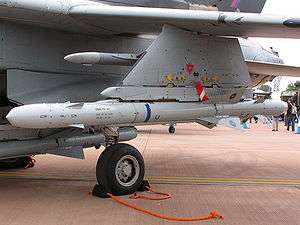Anti-radiation missile
An anti-radiation missile (ARM) is a missile designed to detect and home in on an enemy radio emission source.[1] Typically, these are designed for use against an enemy radar, although jammers[2] and even radios used for communications can also be targeted in this manner.

Earliest known anti radiation missile is variant of Blohm & Voss Bv 246 radar guided missile.[3]
Air-to-surface
Most ARM designs to date have been intended for use against ground-based radars. Commonly carried by specialist aircraft in the Suppression of Enemy Air Defenses (SEAD) role (known to the United States Air Force as "Wild Weasels"), the primary purpose of this type of missile is to degrade enemy air defenses in the first period of a conflict in order to increase the chances of survival for the following waves of strike aircraft. They can also be used to quickly shut down unexpected surface-to-air missile (SAM) sites during an air raid. Often, SEAD escort aircraft also carry cluster bombs, which can be used to ensure that, after the ARM disables the SAM system's radar, the command post, missile launchers, and other components or equipment are also destroyed to guarantee that the SAM site stays down.
Early ARMs, such as the AGM-45 Shrike, were not particularly intelligent; they would simply home in on the source of radiation and explode when they got near it.[4] SAM operators learned to turn their radar off when an ARM was fired at them, then turn it back on later, greatly reducing the missile's effectiveness. This led to the development of more advanced ARMs such as the AGM-78 Standard ARM, AGM-122 Sidearm, and AGM-88 HARM missiles, which have inertial guidance systems (INS) built-in. This allows them to remember the radar's direction if it is turned off and continue to fly towards it. ARMs are less likely to hit the radar if the radar is turned off shortly after the missile is launched, as the longer the radar is off (and assuming it never turns back on), the more error is introduced into the missile's course. The ALARM even has an added loiter mode, with a built-in parachute, enabling it to descend slowly until the radar activates, whereupon the rocket motor will re-ignite. Even a temporary shut down of the enemy's missile guidance radar can be of a great advantage to friendly aircraft during battle.
The DRDO Anti-Radiation Missile has been developed and tested by India.
The MAR-1 is under development by Brazil.
Surface-to-surface
Several surface-to-surface missiles, like the P-700 Granit, P-500 Bazalt, MM40 Exocet, B611MR, and Otomat, include a home-on-jam capability wherein the receiver component of their active radar homing is used to home in on enemy radar, ECM or communications. This makes these missiles significantly harder to defeat with ECM and distraction countermeasures, and makes the use of semi-active missiles against them dangerous.
Surface-to-air
Due to experiences with jamming by US-built aircraft in Vietnam and during Middle Eastern wars in the late 1960s, the Soviet Union designed an alternative tracking mode for their S-75 (SA-2) missiles, which allowed them to track a jamming target without needing to actively send out any radar signals. This was achieved by the SAM site's radar receiver locking on to radio noise emissions generated by an aircraft's jamming pod. In cases of heavy jamming, missiles were often launched exclusively in this mode; this passive tracking meant that SAM sites could track targets without needing to emit any radar signals, and so American anti-radiation missiles could not be fired back in retaliation. Recently, the People's Republic of China developed the FT-2000 system to counter AEW and AWACS targets. This system is based on the HQ-9, which is in turn based on the S-300PMU. These anti-radiation missile systems have been marketed to Pakistan and various other countries.
Air-to-air
More recently, air-to-air ARM designs have begun to appear, notably the Russian Vympel R-27EP. Such missiles have several advantages over other missile guidance techniques: they do not trigger radar warning receivers (conferring a measure of surprise) and they can have a longer range (since the battery life of the seeker head is the limiting factor to the range of most active radar homing systems).
In the 1970s, Hughes Aerospace had a project called BRAZO (Spanish for ARM). Based on a Raytheon AIM-7 Sparrow, it was meant to offer an air-to-air capability against proposed Soviet AWACS types and also some other types with extremely powerful radar sets, such as the MiG-25. The project did not proceed.
See also
References
| Wikimedia Commons has media related to Anti-radiation missiles. |
- "Raytheon Company: High-Speed Anti-Radiation Missile (HARM)". Archived from the original on 6 April 2014. Retrieved 20 May 2014.
- "AGM-88 HARM". Archived from the original on 7 July 2014. Retrieved 20 May 2014.
- Lepage, Jean-Denis G.G. (2009). Aircraft of the Luftwaffe 1935-1945. McFarland. p. 67. ISBN 978-0-7864-3937-9.
- "Texas Instruments AGM-45 Shrike". www.designation-systems.net. Archived from the original on 2013-09-22. Retrieved 2014-05-21.
- Reuben Johnson (February 2006). "Improved Russian radar may level playing field". Asian Aerospace. Archived from the original on 2006-06-14. Retrieved 2006-07-10.
- Russian site on the S-75 from Said Aminov "Vestnik PVO" (in Russian) Google translation
